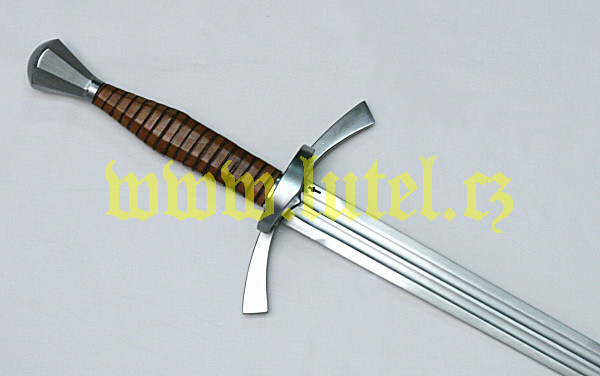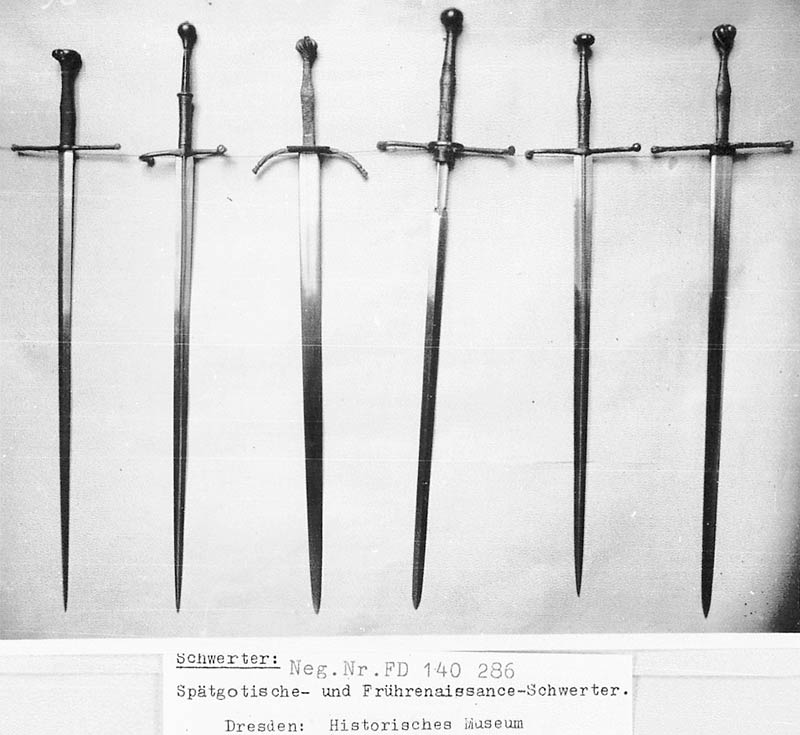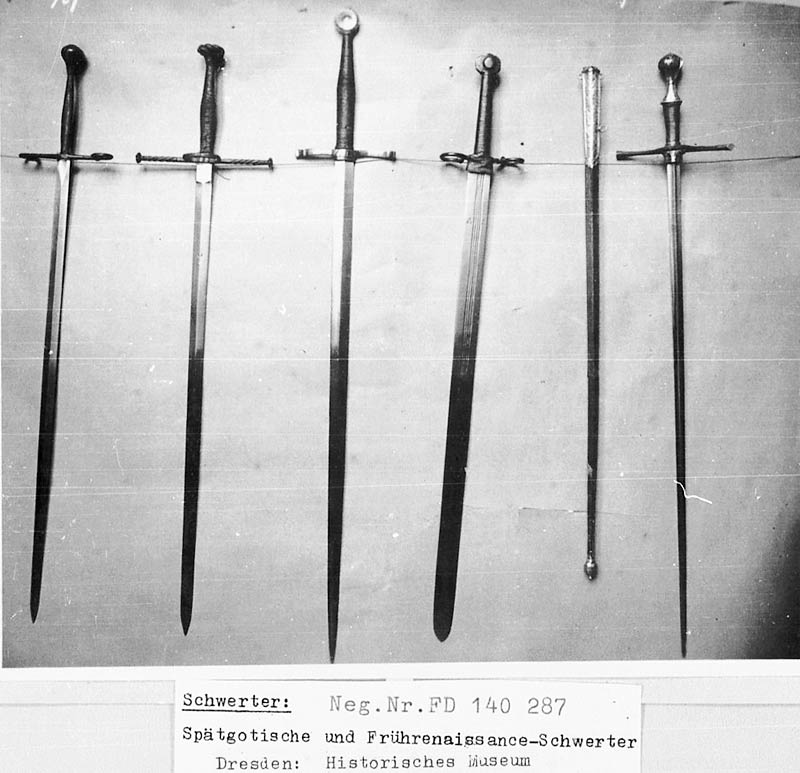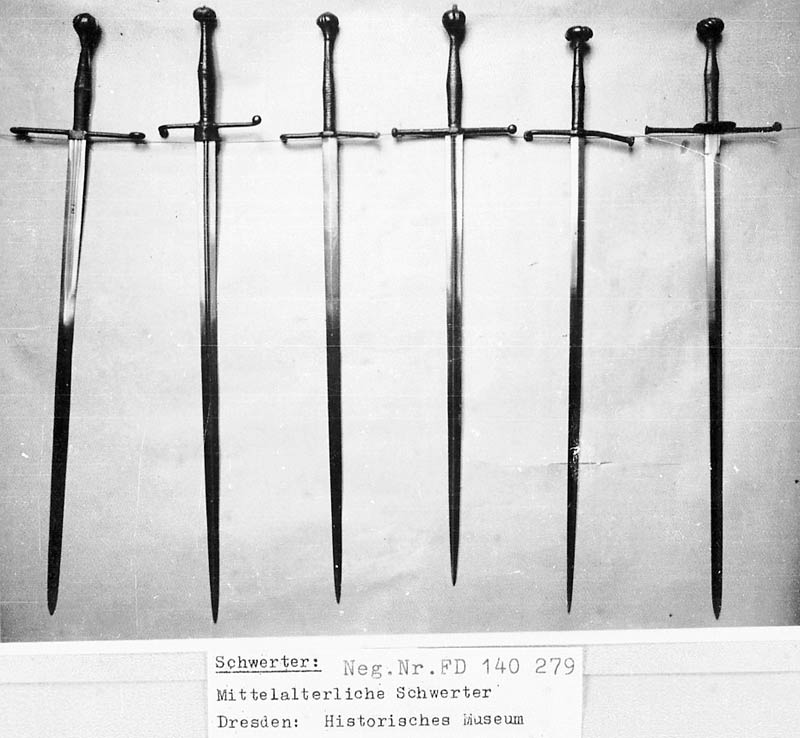I assume that side rings were used in the late 15th and early 16th century since I see so many makers producing swords from that era that have side rings, but I can't seem to find pictures of any antiques.
Most strange though, I have yet to encounter a picture of a sword from the early Renaissance or late middle ages with only a single side ring. I have seen one picture of a longsword with double side rings from the era, but none with single. The only complex guards I seem to find are on later bastard swords, which have guards far more complex than one or two side rings.
I might soon be getting a blunt longsword and would like to have an example found in history to base the design on (it will probably be a semi-custom from Darkwood Armories). Does anyone know of any antique longswords from the late Middle Ages or early Renaissance with just one side ring? Does anyone have pictures of such a sword?
Thanks for replying.
Check out the albums section here on myArmoury. Go to misc. Swords. There are some pics in there of swords with only one side ring.
I don't know if this is exactly what you are looking for but here are two. These might be a little later than what you are looking for. . . I believe that they are both from the 1st quarter of the 16th century.
I don't know if this is exactly what you are looking for but here are two. These might be a little later than what you are looking for. . . I believe that they are both from the 1st quarter of the 16th century.
Thanks for the pics. I haven't seen the first one (an interesting single hander), but the second one (the bastard sword) I already have. Sorry for not mentioning it earlier, but I've scoured through the albums already and that's where I noticed the lack of single side ring longswords. The bastard sword picture you posted is a perfect example of a guard (the combination of one side ring and an arm attached to an inner swept guard) commonly seen on swords of that type (e.g. German waisted bastard swords with a fluted pommel), If anything I think that certainly is some sort of common "family" of swords. The fact that I can't seem to find any longswords with a single side ring when they seem to be so widely produced (especially by czech manufacturers) seems odd. Especially when many of the replica swords with side rings seem to be 15th Century designs.
Sorry if this response was a bit rude, I do sincerely appreciate the effort you've put in.
Sorry if this response was a bit rude, I do sincerely appreciate the effort you've put in.
The myArmoury.com photo albums, while relatively large for such a thing hosted on the 'net, is a very tiny representation of swords and sword types history has left us. The 'net, in general, pales in comparisons to books, museums, and other methods of studying the subject.
Having said that, I see many swords in the albums with side rings.
Circa 1500 (as cited, but seems a bit later, imo):
[ Linked Image ]
Having said that, I see many swords in the albums with side rings.
Circa 1500 (as cited, but seems a bit later, imo):
[ Linked Image ]
| Nathan Robinson wrote: |
| The myArmoury.com photo albums, while relatively large for such a thing hosted on the 'net, is a very tiny representation of swords and sword types history has left us. The 'net, in general, pales in comparisons to books, museums, and other methods of studying the subject.
Having said that, I see many swords in the albums with side rings. Circa 1500 (as cited, but seems a bit later, imo): |
Actually, the sword you posted is another member of the family I described, with side rings and an arm attached to an inner guard. Yes, you are right, those swords seem very common. What isn't common is a 15th or 16th Century longsword with only a side ring (no arms or inner guard). Yet, this design seems very popular with modern manufacturers.
This is the sort of design I am talking about:

A longsword with a single side ring, no arms or inner guard.
Here are a few from the Dresden-Historisches Museum. They are not dated. I'm guessing first half of the 16th century.
 Attachment: 62.35 KB
Attachment: 62.35 KB

Dresden-Historisches Museum
 Attachment: 72.45 KB
Attachment: 72.45 KB

Dresden-Historisches Museum
 Attachment: 64.67 KB
Attachment: 64.67 KB

Dresden-Historisches Museum

Dresden-Historisches Museum

Dresden-Historisches Museum

Dresden-Historisches Museum
| Nathan Robinson wrote: |
| Here are a few from the Dresden-Historisches Museum. They are not dated. I'm guessing first half of the 16th century. |
Oh, man. The XVIIIb's in those photos look KILLER! They look like you could skewer a wild boar on them. I especially like the one in the top photo with the Svante-esque curved guard...
I also really like that pseudo-XVIIIe in the top photo. I just might put off my next sword purchase for another year, so that I can get an Albion Dane customized to look something like that...
I have a question on the purpose of the side ring, especially the front side ring. I know that it will protect the hand when the flat of the blade is used to block a blow but does it also prevent one's opponent from slipping his blade off the rear quilion to attack the arm?
WOW :eek:, that's a lot of swords Nathan! Thanks for the pictures, I rarely see anything but type XIXs with complex guards, and blades that look more like type Xs but definitely aren't in any Oakshott Category. Also, some of the blades you posted look like borderline estoc blades, but that could just be because the fittings seem huge.
Also, just another question, is the development of side rings correlated with the loss or armour, because it occurred to me that the side ring is slightly redundant when you have an armoured gauntlet on your hand.
Also, just another question, is the development of side rings correlated with the loss or armour, because it occurred to me that the side ring is slightly redundant when you have an armoured gauntlet on your hand.
| Sam N. wrote: |
|
Also, just another question, is the development of side rings correlated with the loss or armour, because it occurred to me that the side ring is slightly redundant when you have an armoured gauntlet on your hand. |
In my admittedly limited experience, yes, a side ring is a little redundant when you're wearing a good gauntlet. But I think the development of the complex hilt (including side rings, finger rings, etc) has more to do with unarmored combat, especially judicial dueling.
Swords were a common sight in a duel. But they were merely back-up weapons on the battlefield, sort of like a 9mm Baretta is today.
Having gauntlets on does not mean one wants to get hit on the gauntlets. That sort of hit hurts quite a bit even with gauntlets. Such things are a last line of defense, not a first. Putting further obstacles in the path is preferred over taking a hit to the hands.
By the way, many of the swords in those three photos I posted have a character to their hilts that resembles that found in some of Lutel's offerings, in my opinion. This was one of the factors that caused me to include them here.
Sorry for bumping an old thread, but I think my question is relevant to include here, rather than start a whole new thread ...
Basically, what is the earliest date we have for side rings on longswords / bastard swords?
Most of the historical examples I've seen date from 1510-1520 or so. Arms and Armour's German Bastard Sword says the original they based it on is circa 1500.
However, as their description states,
Now, as we know, most of the German longsword fechtbucher predate 1500. Like many living history folks, my interest is more around the 1470s, so for my case, I'm wondering if side rings would have been found in the latter quarter of the 15th C, rather than 'just' the first quarter of the 16th, when they seem to have been more common.
Nathan posted the pic below over on the Examples of later bastard sword hilts thread:
Is that description really meant to be 'first half of the 15th C' or should it read '16th'?
Anyway, any leads - and images - on side ring/s earlier than 1500 would be greatly appreciated.
And, given Nathan's point above about not getting hit on gauntlets, if anyone has any information about the use of side rings with gauntlets, I'd also be very interested.
Cheers,
Mark T
 Attachment: 34.98 KB
Attachment: 34.98 KB

Basically, what is the earliest date we have for side rings on longswords / bastard swords?
Most of the historical examples I've seen date from 1510-1520 or so. Arms and Armour's German Bastard Sword says the original they based it on is circa 1500.
However, as their description states,
| Quote: |
| The roped guard has a ring on each side for additional hand protection. This was needed as the intricate binding moves of the German school of fence for these types of swords could endanger the hands. |
Now, as we know, most of the German longsword fechtbucher predate 1500. Like many living history folks, my interest is more around the 1470s, so for my case, I'm wondering if side rings would have been found in the latter quarter of the 15th C, rather than 'just' the first quarter of the 16th, when they seem to have been more common.
Nathan posted the pic below over on the Examples of later bastard sword hilts thread:
| Nathan Robinson wrote: |
| A cousin of the sword inspiring A&A's German Bastard Sword? Perhaps...
|
Is that description really meant to be 'first half of the 15th C' or should it read '16th'?
Anyway, any leads - and images - on side ring/s earlier than 1500 would be greatly appreciated.
And, given Nathan's point above about not getting hit on gauntlets, if anyone has any information about the use of side rings with gauntlets, I'd also be very interested.
Cheers,
Mark T

I would say early 16th but not early 15th century but mid to late 15th century seems " possible " to me before they became popular or well documented I'm guessing that there might be early adopters versions from 1460 - 1480 on ?
Some simple finger guards are known on a few early 15th century swords protecting just the index finger when fingering the guard. The more involved rings and multiple branches seem to be much later developments.
http://www.myArmoury.com/view.html?features/pic_spotxix02.jpg
http://www.myArmoury.com/feature_spotxix.html
The Spanish and Italians seem to have been early adopters I think. ( Just a vague impression based on a few Spanish swords that have more decorative and elaborate quillons or multiple quillons and early use of side rings in socalled " side swords ": very early Rapiers or swords with the kind of hilts generally associated with Rapiers? )
I am curious if there is some evidence of earlier than generally accepted use of complex guards.
I can see some being very early if the adoption of complex guard was slow to become fashionable, but if the idea caught on quickly them maybe we are talking only of a couple of decades of the late 15th century.
Some simple finger guards are known on a few early 15th century swords protecting just the index finger when fingering the guard. The more involved rings and multiple branches seem to be much later developments.
http://www.myArmoury.com/view.html?features/pic_spotxix02.jpg
http://www.myArmoury.com/feature_spotxix.html
The Spanish and Italians seem to have been early adopters I think. ( Just a vague impression based on a few Spanish swords that have more decorative and elaborate quillons or multiple quillons and early use of side rings in socalled " side swords ": very early Rapiers or swords with the kind of hilts generally associated with Rapiers? )
I am curious if there is some evidence of earlier than generally accepted use of complex guards.
I can see some being very early if the adoption of complex guard was slow to become fashionable, but if the idea caught on quickly them maybe we are talking only of a couple of decades of the late 15th century.
Hi Jean,
Thanks for that ... I just noticed that I'd missed the text saying 'now mounted with a hilt in mid-German 16th Century style / The blade first half of the 15th Century' - so that clears up that question.
It's specfically side rings, rather than finger guards that I'm interested in - partly due to the protection they provide, and also because I'm curious if they would ever have been used in conjunction with the German techniques that require the thumb to be placed on the blade.
I'm hoping for the 'early adopter' theory too, but would love to see any documentation of 15th C examples!
Thanks for that ... I just noticed that I'd missed the text saying 'now mounted with a hilt in mid-German 16th Century style / The blade first half of the 15th Century' - so that clears up that question.
It's specfically side rings, rather than finger guards that I'm interested in - partly due to the protection they provide, and also because I'm curious if they would ever have been used in conjunction with the German techniques that require the thumb to be placed on the blade.
I'm hoping for the 'early adopter' theory too, but would love to see any documentation of 15th C examples!
Thread revival! Like Mark T, I would also like to see longswords with siderings from before 1500, 1470's would be great... :)
I don't think you're going to find them much earlier than ca.1500.
Thanks for posting that great photo, Murphy. Can you post any other photos you took, please. I've not managed to get to Burg Eltz but it looks like it's got a good collection. Thanks.
Neil
Neil
I didn't take them. My brother took them. But, here's the other weapon pics from Burg Eltz that he sent to me-
[ Linked Image ]
[ Linked Image ]
[ Linked Image ]
Now, if I make it to Frankfurt, my photography will encompass SO much more. However, this is what I have from him.
Murphy :cool:
[ Linked Image ]
[ Linked Image ]
[ Linked Image ]
Now, if I make it to Frankfurt, my photography will encompass SO much more. However, this is what I have from him.
Murphy :cool:
Page 1 of 1
You cannot post new topics in this forumYou cannot reply to topics in this forum
You cannot edit your posts in this forum
You cannot delete your posts in this forum
You cannot vote in polls in this forum
You cannot attach files in this forum
You can download files in this forum
All contents © Copyright 2003-2006 myArmoury.com — All rights reserved
Discussion forums powered by phpBB © The phpBB Group
Switch to the Full-featured Version of the forum
Discussion forums powered by phpBB © The phpBB Group
Switch to the Full-featured Version of the forum